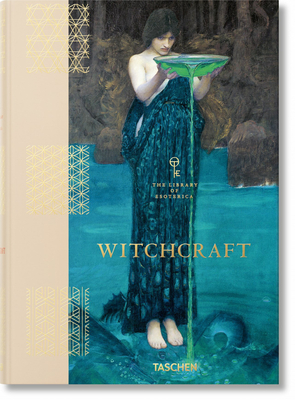Edited by Jessica Hundley and Pam Grossman
Taschen ($40)
by Patrick James Dunagan
What makes a witch a witch, and what is witchcraft for? These are among the central questions explored in the lavishly illustrated Witchcraft, the latest release in Taschen’s Library of Esoterica series. Images of witches throughout the ages and in various styles are robustly represented, with visualizations of the coquettish and the stridently sexy appearing alongside hags of old and earth mothers of today. The illustrations are notable for being reproduced at remarkably high quality—which is essential, for often the artists have included key details buried in murky colors and shading. It’s wonderful to be able to notice what’s lurking in dark corners.
Not surprisingly, a colossal number of brooms, cauldrons, ghouls, devils, goats, wands, and outdoor fire dances make appearances in Witchcraft, yet there are also tranquil moon-lit scenes and lush woodland vistas aplenty. Nowadays witches are far less commonly viewed as raggedy and grotesque, flying around on brooms in the night and menacing town and countryside alike. Much discussion in this book is thus given over to unpacking the vast number of preconceptions and misunderstandings about witches, part of a growing tolerance that helps witches today stand proud, announcing themselves to the public without fear or hesitancy. In many communities, particularly in the arts, declaring oneself a witch is even fashionable.
For that reason, it’s also not too surprising that many an artist in Witchcraft self-identifies herself, or rarer himself, as a witch. Practitioners of the arts and the occult readily share affinities: “Like a witch, the artist conjures, shapes reality, manifests . . . One makes magick. One engages in ‘the craft.’” Remedios Varo and Leonora Carrington, for example, are two artists associated with Surrealism whose work is included in this book. Close friends while living in the expatriated European community in Mexico City, they were both influenced by occultism; in works by such artists, “many aspects of the witch in art history and in the popular imagination were revisited and reimagined,” opening paths to a wider reinterpretation and embracing of witchcraft. Visual artists Betye Saar and Cameron, for example, both from Los Angeles, offer wonderful instances of the artist embedding (as well as embodying, in Cameron’s case) witchcraft symbolism and practice in works of art.
Many more examples of the Artist-as-Witch abound, and this book may inspire readers to think of them. In the literary world, novelist Norman Mailer's avowed maintenance of his “relationship” to substances (whiskey and pot) in his writing practice seems as witchy as poet Diane di Prima's 1980s declaration that she started putting on a few pounds in order to keep the demons out. Poetry examples are in fact numerous: Alice Notley has used the symbol of a white owl often, and during the presidency of George W. Bush, described her recurring dream of such a creature carrying him far away from the White House; Joanne Kyger developed a practice of breathing along with the bamboo across from her front porch, welcoming and congratulating its breath with her own. Witchcraft invites and celebrates readers making connections such as these, identifying the predominance of witchy practice that inundate and intersect with creative life.
Witch Janet Farrar sounds much like a poet when she makes this recommendation to aspiring witches: “Read as much as you can, but be critical of what you read. Stick to your original vision of what craft is, and don’t be swayed by those who try to shoehorn you into their form of practice.” Any MFA candidate in poetry would be wise to follow this tip. Such common-sense advice is found everywhere in these pages, as in this discussion of practicing Necromancy: “the dead will become visible to you, and you will be able to request information from them. Speak politely and wear an amulet.”
Several statements by contemporary witches demonstrate how witchcraft is not only useful, but essential in our rapidly diversifying appreciation for each other’s differences. “The witch can help us find our way through what I call ‘the evolutionary chaos of now,’” says Robin Rose Bennett, and Edgar Fabián Frías observes that “Witches banish borders and binaries and allow for prismatic visions to take root.” At its heart, witchcraft focuses on the liberation of the individual. Like all good anti-establishment heroes, “Witches only care about empire when they want to burn it down.”
Click here to purchase this book at your local independent bookstore
Rain Taxi Online Edition Summer 2022 | © Rain Taxi, Inc. 2022


